-
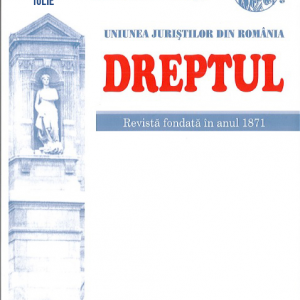 The author reveals a series of analogies, contradictions between Articles 98-103 of the new Civil Code (Law No. 287/2009 republished on July 15th, 2011 and effective since October 1st, 2011) and Law No. 119/1996 (republished on November 2nd, 2009) on the civil status documents, situation which, on the one hand brings about a series of difficulties as regards the correct interpretation and enforcement of the law, and, on the other hand, is in breach of the rules of principle of Law No. 24/2000 laying down detailed rules on the legislative technique for drafting regulations (republished on April 21st, 2010).
The author reveals a series of analogies, contradictions between Articles 98-103 of the new Civil Code (Law No. 287/2009 republished on July 15th, 2011 and effective since October 1st, 2011) and Law No. 119/1996 (republished on November 2nd, 2009) on the civil status documents, situation which, on the one hand brings about a series of difficulties as regards the correct interpretation and enforcement of the law, and, on the other hand, is in breach of the rules of principle of Law No. 24/2000 laying down detailed rules on the legislative technique for drafting regulations (republished on April 21st, 2010). -
 In essence, the article emphasizes the inconsistent practice of the courts, as regards the consequences of changing the legal classification of the criminal offence – the subject matter of the judgment – by indictment, an action of initiating proceedings before the court, on the means of appeal in the criminal trial. The legal matter under discussion takes into consideration the impact of the provisions of art. 361, paragraph 1, letter a) of the Criminal Procedure Code and of art. 3851 paragraph 1, letter d1 of the Criminal Procedure Code, according to which the judgments regarding criminal offences for which the initiation of criminal procedure is carried out following the preliminary complaint of the injured person cannot be challenged with an appeal, but only with a second appeal . Thus, in relation to the new legal classification of the criminal offence – the subject matter of the judgment – the means of appeal that can be used in such criminal cases must be established. In our opinion, in case of changing the legal classification, the legal classification given to the criminal offence – the subject matter of the judgment – by the court whose decision is subject to judicial review is decisive in establishing the means of appeal.
In essence, the article emphasizes the inconsistent practice of the courts, as regards the consequences of changing the legal classification of the criminal offence – the subject matter of the judgment – by indictment, an action of initiating proceedings before the court, on the means of appeal in the criminal trial. The legal matter under discussion takes into consideration the impact of the provisions of art. 361, paragraph 1, letter a) of the Criminal Procedure Code and of art. 3851 paragraph 1, letter d1 of the Criminal Procedure Code, according to which the judgments regarding criminal offences for which the initiation of criminal procedure is carried out following the preliminary complaint of the injured person cannot be challenged with an appeal, but only with a second appeal . Thus, in relation to the new legal classification of the criminal offence – the subject matter of the judgment – the means of appeal that can be used in such criminal cases must be established. In our opinion, in case of changing the legal classification, the legal classification given to the criminal offence – the subject matter of the judgment – by the court whose decision is subject to judicial review is decisive in establishing the means of appeal. -
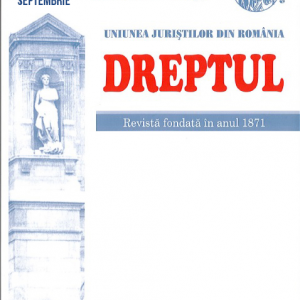 In this study, the authors emphasize some aspects of administrative practice on marriage before attaining the legal minimum marriage age provided by law. These comments relate in particular: lack of consistency in preparing related applications relating to request age waiver; superficiality shown on preparing, presentation, or acceptance of reasons for the foundation of this marriage; the proceeding and the method when this marriage is accepted by the parents, tutor or other person or authority/ institution empowered to exercise parental rights. These critical remarks are correlated and reasoned with the legal provisions, offering their views on the administrative practice.
In this study, the authors emphasize some aspects of administrative practice on marriage before attaining the legal minimum marriage age provided by law. These comments relate in particular: lack of consistency in preparing related applications relating to request age waiver; superficiality shown on preparing, presentation, or acceptance of reasons for the foundation of this marriage; the proceeding and the method when this marriage is accepted by the parents, tutor or other person or authority/ institution empowered to exercise parental rights. These critical remarks are correlated and reasoned with the legal provisions, offering their views on the administrative practice. -
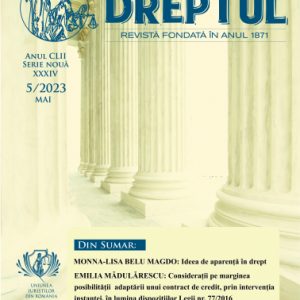
-
 The article sets under review the opportunity to pursue criminal action as an institution of novelty in the field of criminal procedure, by the Prosecutor’s possibility to assess the existence of real public interest in carrying out the investigation and to rule, subject to certain conditions, upon the solution of abandoning criminal prosecution, provided that practical circumstances of the offence committed reveal that this interest does not subsist.
The article sets under review the opportunity to pursue criminal action as an institution of novelty in the field of criminal procedure, by the Prosecutor’s possibility to assess the existence of real public interest in carrying out the investigation and to rule, subject to certain conditions, upon the solution of abandoning criminal prosecution, provided that practical circumstances of the offence committed reveal that this interest does not subsist. -
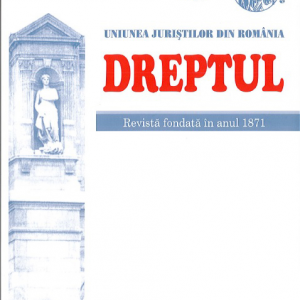 The author’s approach is intended for a partially critical analysis of the Decision of the Constitutional Court No 225 of 4 April 20172, by which the phrase „likely to prejudice the prestige of the profession” within Article 14 a) of the Law No 51/1995 was declared unconstitutional. The Constitutional Court has held that the criticized text is devoid of precision, clarity and predictability, as it does not circumstantiate the scope of the offences likely to cause the unworthiness in the profession of lawyer. The author considers that this solution of unconstitutionality makes an exaggerated interpretation of the incidental legal provisions, unduly restricting the right of appreciation of the competent structures of the professional organization of lawyers and of the judge called to settle any possible disputes. Within this study it is noted that there are various other situations in which the right of appreciation of the judge can not be challenged in our legal system. The approach included in this study also insists on the consequences which can be determined by the analysed solution of unconstitutionality, due to the existence of some identical or very similar provisions in respect of other liberal legal professions as well. A cavalcade of pleas of unconstitutionality, based on similar considerations, could raise for discussion other important institutions of law as well, such as those concerning the disciplinary, contraventional, civil or even criminal liability.
The author’s approach is intended for a partially critical analysis of the Decision of the Constitutional Court No 225 of 4 April 20172, by which the phrase „likely to prejudice the prestige of the profession” within Article 14 a) of the Law No 51/1995 was declared unconstitutional. The Constitutional Court has held that the criticized text is devoid of precision, clarity and predictability, as it does not circumstantiate the scope of the offences likely to cause the unworthiness in the profession of lawyer. The author considers that this solution of unconstitutionality makes an exaggerated interpretation of the incidental legal provisions, unduly restricting the right of appreciation of the competent structures of the professional organization of lawyers and of the judge called to settle any possible disputes. Within this study it is noted that there are various other situations in which the right of appreciation of the judge can not be challenged in our legal system. The approach included in this study also insists on the consequences which can be determined by the analysed solution of unconstitutionality, due to the existence of some identical or very similar provisions in respect of other liberal legal professions as well. A cavalcade of pleas of unconstitutionality, based on similar considerations, could raise for discussion other important institutions of law as well, such as those concerning the disciplinary, contraventional, civil or even criminal liability. -
 În cauza dedusă judecății apelantul a susținut că nu se justifică măsura evacuării sale din locuință, întrucât această măsură îl împiedică să participe la anumite evenimente din viața fiicei sale și să păstreze relațiile personale cu aceasta. Însă atât timp cât aceste relații nu au fost interzise de către o instanță judecătorească, iar autoritatea părintească este exercitată în continuare, în comun, de către ambii părinți, în mod egal, conform art. 503 alin. (1) C.civ., tatăl apelant nu este afectat în exercitarea drepturilor și obligațiilor părintești, decât în mică parte, prin măsura evacuării din locuința familiei, întrucât există multe alte modalități pe care le are la dispoziție pentru menținerea relațiilor cu minora, chiar și în această perioadă în care este instituită starea de urgență. (Tribunalul Galați, Decizia civilă nr. 229 din 27 aprilie 2020, definitivă).
În cauza dedusă judecății apelantul a susținut că nu se justifică măsura evacuării sale din locuință, întrucât această măsură îl împiedică să participe la anumite evenimente din viața fiicei sale și să păstreze relațiile personale cu aceasta. Însă atât timp cât aceste relații nu au fost interzise de către o instanță judecătorească, iar autoritatea părintească este exercitată în continuare, în comun, de către ambii părinți, în mod egal, conform art. 503 alin. (1) C.civ., tatăl apelant nu este afectat în exercitarea drepturilor și obligațiilor părintești, decât în mică parte, prin măsura evacuării din locuința familiei, întrucât există multe alte modalități pe care le are la dispoziție pentru menținerea relațiilor cu minora, chiar și în această perioadă în care este instituită starea de urgență. (Tribunalul Galați, Decizia civilă nr. 229 din 27 aprilie 2020, definitivă). -
 The importance of distributing of the amounts in the insolvency procedure is unquestionable. Practically, only at this point in time, the purpose of the insolvency procedure from the point of view of creditors can be palpable and achievable by covering their claims. The legislator’s imperativeness in relation to the order of payment of the claims, respectively of the distribution of the amounts obtained from liquidation, found in the legal regulations, is based mainly on the economic, social, humanitarian and juridical aspects of each type of claim and on the impact that the insolvency procedure, respectively the recovery or non-recovery of claims, may have on each category of creditors. In the context of the entry into force of the Law No 85/2014 on the procedures for preventing insolvency and for insolvency, we propose to analyze the procedure for the distribution of amounts and the order of payment of claims, in a comparative overview as to the old regulation, by emphasizing the notable differences in this field. At the same time, we will perceive this study by structuring it depending on the order of distribution of the amounts within the two fundamental categories of claims, namely the guaranteed claims and secured claims
The importance of distributing of the amounts in the insolvency procedure is unquestionable. Practically, only at this point in time, the purpose of the insolvency procedure from the point of view of creditors can be palpable and achievable by covering their claims. The legislator’s imperativeness in relation to the order of payment of the claims, respectively of the distribution of the amounts obtained from liquidation, found in the legal regulations, is based mainly on the economic, social, humanitarian and juridical aspects of each type of claim and on the impact that the insolvency procedure, respectively the recovery or non-recovery of claims, may have on each category of creditors. In the context of the entry into force of the Law No 85/2014 on the procedures for preventing insolvency and for insolvency, we propose to analyze the procedure for the distribution of amounts and the order of payment of claims, in a comparative overview as to the old regulation, by emphasizing the notable differences in this field. At the same time, we will perceive this study by structuring it depending on the order of distribution of the amounts within the two fundamental categories of claims, namely the guaranteed claims and secured claims -
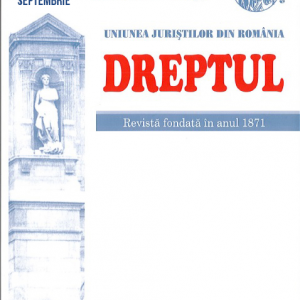 In this study, the author analyzes, in the light of the Convention for the Protection of Human Rights and Fundamental Freedoms, the manner of observing the principle of impartiality of the Romanian judges within the national procedures regarding the establishment and functioning of the associations and foundations. Within the introductory section, general elements regarding the freedom of peaceful assembly and association are presented, according to Article 11 of the Convention. Subsequently, the relevant provisions of the Government Ordinance No 26/2000 on associations and foundations are emphasized. Their analysis, from the perspective of the civil side of Article 6 § 1 of the Convention for the Protection of Human Rights and Fundamental Freedoms,considers the minimum standard imposed on Romania by this treaty. After presenting the conventional reference provisions applicable at the level of the Member States of the Council of Europe, the author demonstrates the lack of a hermetic delimitation between the subjective impartiality and the objective impartiality of the national judge, in the analyzed hypothesis. At the same time, it is outlined the need to respect the role of neutral arbitrator of the court. Based on the rich case law of the European Court of Human Rights, the author manages to capture the shortcomings of the national regulation. This study includes both a theoretical and practical debate on the obligations and responsibility of the Romanian state, according to the Convention, and a proposal de lege ferenda, in order to respect the principle of impartiality of judges. In relation to the large number of case files registered annually by courts of first instance, regarding the establishment and functioning of associations and foundations, the study is also an alarm signal, in order to avoid the responsibility of the Romanian state, according to the Convention for the Protection of Human Rights and Fundamental Freedoms.
In this study, the author analyzes, in the light of the Convention for the Protection of Human Rights and Fundamental Freedoms, the manner of observing the principle of impartiality of the Romanian judges within the national procedures regarding the establishment and functioning of the associations and foundations. Within the introductory section, general elements regarding the freedom of peaceful assembly and association are presented, according to Article 11 of the Convention. Subsequently, the relevant provisions of the Government Ordinance No 26/2000 on associations and foundations are emphasized. Their analysis, from the perspective of the civil side of Article 6 § 1 of the Convention for the Protection of Human Rights and Fundamental Freedoms,considers the minimum standard imposed on Romania by this treaty. After presenting the conventional reference provisions applicable at the level of the Member States of the Council of Europe, the author demonstrates the lack of a hermetic delimitation between the subjective impartiality and the objective impartiality of the national judge, in the analyzed hypothesis. At the same time, it is outlined the need to respect the role of neutral arbitrator of the court. Based on the rich case law of the European Court of Human Rights, the author manages to capture the shortcomings of the national regulation. This study includes both a theoretical and practical debate on the obligations and responsibility of the Romanian state, according to the Convention, and a proposal de lege ferenda, in order to respect the principle of impartiality of judges. In relation to the large number of case files registered annually by courts of first instance, regarding the establishment and functioning of associations and foundations, the study is also an alarm signal, in order to avoid the responsibility of the Romanian state, according to the Convention for the Protection of Human Rights and Fundamental Freedoms. -
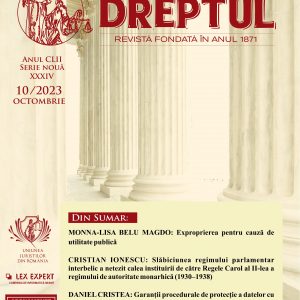
-
 Paulian action represents, alongside oblique action and direct action, one of the most important means of protecting creditors in general. However, unlike direct actions, this legal mechanism provides general protection to all creditors, not just a few that are mentioned by the law. Against this backdrop, in the light of economic development and the many contracts concluded lately, especially in recent years, the knowledge of rights and the means of creditor protection should be of interest to all creditors. Unfortunately, although the paulian action is expressly provided for by law, creditors rarely resort to this legal mechanism to ensure the protection of their own claims. This reluctance is likely to arise from the fear of a long and cumbersome move to promote a litigation in the form of a paulian action. From this point of view, we hope that the present study will provide practitioners, theorists, and creditors with detailed information about this legal mechanism, to encourage the promotion of a paulian action whenever borrowers act against patrimony in order to avoid enforcement.
Paulian action represents, alongside oblique action and direct action, one of the most important means of protecting creditors in general. However, unlike direct actions, this legal mechanism provides general protection to all creditors, not just a few that are mentioned by the law. Against this backdrop, in the light of economic development and the many contracts concluded lately, especially in recent years, the knowledge of rights and the means of creditor protection should be of interest to all creditors. Unfortunately, although the paulian action is expressly provided for by law, creditors rarely resort to this legal mechanism to ensure the protection of their own claims. This reluctance is likely to arise from the fear of a long and cumbersome move to promote a litigation in the form of a paulian action. From this point of view, we hope that the present study will provide practitioners, theorists, and creditors with detailed information about this legal mechanism, to encourage the promotion of a paulian action whenever borrowers act against patrimony in order to avoid enforcement. -
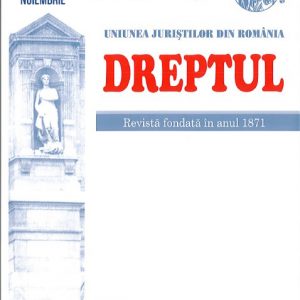 Stipulation for another and direct actions are two topical legal mechanisms that, although in theory are clearly explained, the judicial practice is hesitant in their application. At the same time, due to the multitude of similarities regarding the effects of these legal mechanisms, a confusion has been created in numerous situations both in terms of their legal meaning and their applicability. As such, a comparative study of the two legal notions contributes and facilitates the substantiation in law of the stipulation for another and of the direct actions, but also the way of application in the judicial practice. In the present study we mainly focused on presenting the origins of the stipulation for another, but also on its application over time, so far, concluding with a comparison with the direct actions, regarding the main effects of the two legal mechanisms. We hope that the judicial practice will outline in time a more effective differentiation of the two notions with a wide spread in the fields of law.
Stipulation for another and direct actions are two topical legal mechanisms that, although in theory are clearly explained, the judicial practice is hesitant in their application. At the same time, due to the multitude of similarities regarding the effects of these legal mechanisms, a confusion has been created in numerous situations both in terms of their legal meaning and their applicability. As such, a comparative study of the two legal notions contributes and facilitates the substantiation in law of the stipulation for another and of the direct actions, but also the way of application in the judicial practice. In the present study we mainly focused on presenting the origins of the stipulation for another, but also on its application over time, so far, concluding with a comparison with the direct actions, regarding the main effects of the two legal mechanisms. We hope that the judicial practice will outline in time a more effective differentiation of the two notions with a wide spread in the fields of law.
